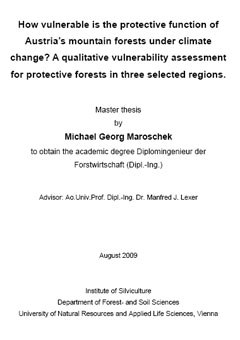Publications
How vulnerable is the protective function of Austria’s mountain forests under climate change?
| Year of publication | 2009 |
|---|---|
| Author(s) | Michael Georg Maroschek |
| Publisher(s) | Institut für Waldbau |
| Language | en |
| Purchase | https://zidapps.boku.ac.at/abstracts/download |
| Page(s) | 167 |
| Publication type | Diploma thesis |
During the last decades the increase in temperature in the European Alps was about twice as high as the global average. This pattern is recurrent in climate change scenarios for the 21st century. The expected climatic changes may affect mountain forests at a broad range including the provision of forest goods and services. Here the focus is on the protective function against natural hazards. A scheme for a regional vulnerability assessment is developed and demonstrated by means of three case studies from Austria. Based on existing assessment schemes the sensitivity of forest ecosystems and hazardous processes to climate changes was inferred from current state and expected response regarding exposure to climate change. Blending ecosystem and hazard sensitivity yields potential impacts on the protective functions against flooding, debris flow, landslide, rock fall and snow avalanches. Regional adaptive capacity was estimated from a set of indicators reflecting forest infrastructure, administrative and organizational aspects. Vulnerability in three categories resulted from the combination of potential impacts and adaptive capacity. The assessment is based on a literature review, readily available regional forest inventory data and expert knowledge. For the analysis of the case studies the A1B climate change scenario from REMO-UBA was used. In the assessment two time periods were distinguished (2021-2050, 2071-2100). The selected case studies showed different vulnerabilities with regard to temporal development as well as to the magnitude of potential impacts. The results of the literature review revealed knowledge gaps with respect to climate change effects on forest regeneration and biotic disturbances, hazardous processes and extreme climate events. The application of the vulnerability assessment scheme is demonstrated successfully. However, due to the encountered knowledge gaps the results are subject to uncertainty.


